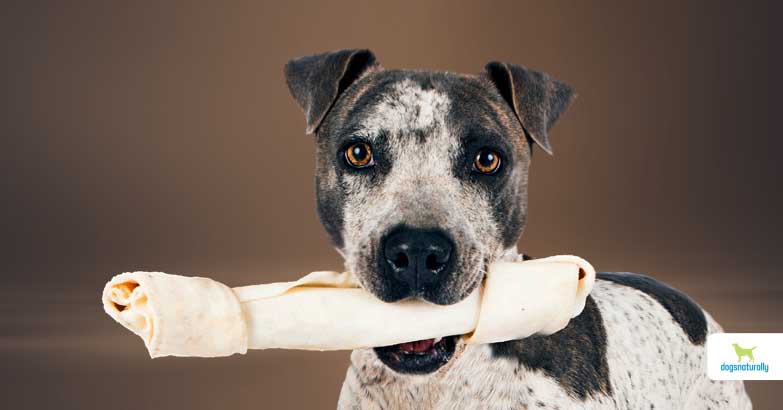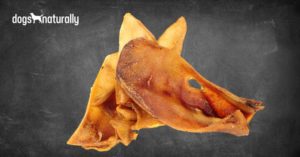Rawhide is one of the most popular chews for dogs … but just because it can keep your dog chewing for hours doesn’t mean it’s healthy. So … is rawhide bad for dogs?
The short answer is that rawhide can be really dangerous for your pets … whether you have puppies or an adult dog. Many dog owners aren’t aware of rawhide’s risks or poor quality control standards.
In fact, many dog owners still believe rawhide dog chews are healthy or even improve dental health for their pets.
So let’s take a closer look and get to the bottom of the question … is rawhide bad for dogs?
What Is Rawhide?
Rawhide is described as a natural chew … but it isn’t really a nice piece of dried beef skin made into shapes, as many people believe. A rawhide chew toy is made with leftovers from the leather industry … and here’s how they do it.
How Rawhide Chews Are Made
First, the hides from the slaughterhouse are placed into a brine to help slow their decay (it doesn’t stop them from rotting … just slows the process a bit). The hides aren’t only from beef …they can be from any animal used in leather manufacturing.
1. Processing
The brined hides are shipped to tanneries, where the fat and hair are removed. This is done using chemicals like an ash-lye solution, or sodium sulphide liming, which is highly toxic.
Next the hides are treated with more chemicals that puff the hide, making it easier to split into layers. The outer layer of the hide is used to make leather goods like car seats, clothing, shoes, or purses. The inner layer is what’s used to make your dog’s rawhide (as well as other products like gelatin, cosmetics, and glue).
Next, this inner layer is washed and whitened using a solution of hydrogen peroxide, bleach or other stronger chemicals. This also helps remove the smell that’s developed from the now decayed, rotten leather. (Remember, the brine only slows the decay – it doesn’t prevent it.)
In 2017, the FDA announced a recall of rawhide chews from Mexico, Colombia and Brazil. They’d been processed using a quaternary ammonium compound mixture that’s an anti-microbial chemical approved for cleaning food processing equipment, but is not approved in the US for production of rawhide chews.
2. Coloring
Now it’s time to make the whitened sheets of this leathery by-product look like something delicious for your dog. That’s where the decorative process comes in.
Rawhide chews can be basted with flavors, or smoked … and dyed in different artificial colors. They may even be painted with titanium oxide, which makes them look white and attractive.
Chemicals used in this process may include toxic products. One of them is FD&C Red 40, a petroleum-based food dye that’s linked to behavior disorders like ADHD in children, as well as allergies and migraines.
3. Preserving
Once rawhide chews or rawhide bones have been made, they’re preserved with various chemicals. These can include formaldehyde or chromium salts. When rawhide chews have been tested, they’ve shown things like lead, arsenic, mercury and other toxic metals as well.
The rawhides are made into many shapes … rolls, bones, knots, braids, donuts and more. Manufacturers may also use different types of glues in making these rawhide shapes.
Why Is Rawhide Chew Bad For Dogs?
There are two big reasons rawhide is bad for dogs: the chemical processing described above, and the risk of choking or intestinal blockage.
Chemicals You’ve seen from the above description of how rawhide is made, that there’s not much that’s “natural” about rawhide for your dog. It’s a piece of useless leftover animal skin … bathed, soaked and colored with countless toxic chemicals.
Most rawhide treats are made outside the US (often in China). If you shop carefully, you might be able to find US-made rawhide chews that aren’t chemically treated. But rawhide is still bad for dogs.
Choking Or Blockage Chemicals aren’t the only reason rawhide is bad for dogs. Rawhide chews are very indigestible and can often lead to choking, or blockages in the digestive tract.
If your dog swallows large pieces of rawhide, they can get stuck in the esophagus or lower in the digestive tract. It’s quite common for dogs to need emergency abdominal surgery to remove them from the stomach or intestines. Otherwise, these indigestible pieces can sit in the stomach for months without being digested.
This can cause digestive problems … and eventually create dangerous intestinal blockages. Eventually, these obstructions can lead to death if not removed.
Sometimes this type of blockage can be removed with endoscopy, but if the obstruction is too low in the digestive system, surgery is needed. So if you think your dog has swallowed a piece of rawhide that could be stuck, get to your vet quickly to avoid a potentially life threatening problem.
Is Dog Rawhide Good For Dental Health?
Rawhide manufacturers claim that chewing on rawhide helps clean and strengthen dogs’ teeth. But that’s not true. Rawhide chews start out hard, but as your dog chews, they get softer and develop a chewy, indigestible consistency. At that point, it’s not doing anything to help your dog’s teeth … but it’s still a big choking and intestinal obstruction risk for your dog.
Plus, even if rawhide chews were great for your dog’s teeth, they still wouldn’t be worth the risks. There are other ways to keep your dog’s teeth clean without posing a health risk.
How Long Does it Take for a Dog to Digest Rawhide?
Do you have small dogs? Senior dogs? A large dog?
Does your dog tend to bite off large chunks or small ones?
These factors can all influence how long it takes for your dog to digest rawhide.
As a general rule though, rawhide is notoriously difficult for dogs to digest due to its dense and tough nature. If your dog is able to chew it into small, manageable pieces, those pieces might pass through the digestive system in 24 to 72 hours. Yet, this is an ideal scenario and doesn’t account for the risks associated with larger, indigestible pieces.
Larger pieces of rawhide can pose a significant risk as they may not digest at all, leading to potential blockages in the intestines. These blockages can be life-threatening and may require surgical intervention to resolve.
But the concern with rawhide isn’t just about how long it takes to digest. There’s also the possibility that it might be digested enough to pass through safely. Especially if your dog is an aggressive chewer, and swallows larger rawhide bites of various shapes.
What Can I Give My Dog Instead Of Rawhide Treats?
There are many rawhide alternatives out there that are safer and healthier than traditional rawhide. Let’s look at some more digestible alternatives to rawhide that can still satisfy your dog’s chewing.
Recreational Bones The best kind of chew for adult dogs is a raw, recreational bone. Recreational bones are different from raw meaty bones given as food. Raw meaty bones are usually softer bones that your dog can completely chew up and swallow. These are an important source of protein, calcium and other minerals).
But, as the name suggests, recreational bones only provide entertainment and activity for your dog. They’re not an important part of his nutrition.
But in addition to giving your dog entertainment, they’ll also strengthen his jaw, neck and shoulder muscles. They’ll do a great job of cleaning his teeth as well.
So while he may get a few nutrients from meat or cartilage left on them … their main purpose is for entertainment and oral health
Dried Meat Products If you don’t want to give your dog raw bones, the next best choices for dog treats are natural dehydrated meat products. Examples of these are dehydrated beef trachea … or bully sticks that are made from bull penises.
These won’t last as long as a rawhide chew. But they’ll give your dog some good chewing activity and they’re much safer and more digestible than rawhide chews.
Some dogs love chewing on elk antlers or deer antlers … but these are very hard and can break teeth, or even be a choking hazard.
Other options include manufactured “dental chews” made from various materials. These aren’t usually natural, and it’s doubtful whether they actually help clean dogs’ teeth. If you use these, just make sure they’re made from non-toxic ingredients that can’t harm your dog.
How Can I Make Rawhide Chews Safer For My Pet?
Rawhide chews are inherently risky. That’s why we recommend safer alternatives. But there are steps you can take to make rawhide products safer for your pet, if you still choose to offer them as a treat.
Firstly, source rawhide chews from reputable manufacturers. This alone will reduce the risk of chemical exposure. Look for rawhides that explicitly state they are free from chemical treatments, dyes, and preservatives.
Offering rawhide under supervision is another critical step. Never leave your dog unattended while they’re enjoying their chew. This way, you can quickly intervene if a piece breaks off that might cause choking or intestinal blockage.
Also, consider your pup’s chewing habits and size. Smaller, more easily digestible pieces might be suitable for gentle chewers. Aggressive chewers might need closer supervision or alternatives to rawhide.
Should I Avoid Rawhides Altogether?
We advise avoiding rawhide altogether. This is because of the risks associated with it (chemical exposure, choking, intestinal blockage, etc).
The process of making rawhide is fraught with chemical treatments, and even the “safer” options pose a risk if ingested in large pieces.
The safe alternatives to rawhide that we highlighted above can satisfy your dog’s need to chew without the associated risks.
You’re better off giving your pup recreational bones, dehydrated meat products, and other long lasting chews. These can keep your pup’s teeth clean and jaws strong without the dangers of rawhide.
Bottom Line | Is Rawhide Bad For Dogs?
Overall, rawhide isn’t worth the risk to your dog, however much he might enjoy it.
So next time someone gives your furry friend an enticing-looking rawhide “bone,” you might be better off taking it back to the pet store. Or just throwing it away.
FAQ
Here are some other common questions we receive from dog owners about rawhide for dogs …
Is rawhide actually bad for dogs? Yes, rawhide can be bad for dogs. Rawhide chews pose risks such as choking, intestinal blockage, and exposure to toxic chemicals.
Do vets recommend rawhide for dogs? Most vets caution against giving rawhide to dogs due to the risks of choking, gastrointestinal blockage, and potential for chemical contamination. Vets often suggest safer chewing alternatives that promote dental health without the risks associated with rawhide.
Does rawhide break down in a dog’s stomach? Rawhide does not easily break down in a dog’s stomach. Due to its tough and dense nature, rawhide can be difficult for dogs to digest, potentially leading to gastrointestinal blockages or obstructions.
What kind of rawhide is safe for dogs? Traditional rawhide poses risks, but there are safer alternatives, such as rawhide made in the USA from high-quality, single-source ingredients with no added chemicals. However, it’s best to select chew toys or treats that are safer and fully digestible.













